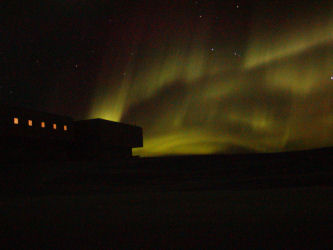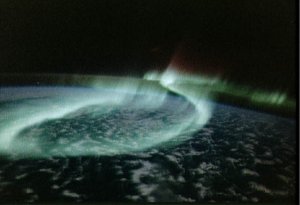 "Peacock Aurora" © 2007 RL.Dietz
"Peacock Aurora" © 2007 RL.Dietz
`
|
Auroral activity strongly correlates with solar activity.
Peak activity repeats on an 11-year cycle. The story begins with the solar surface which continuously
emits charged particles such as protons and electrons. These particles are collectively known as the Solar Wind.
The particles stream through the solar system at 400 km/s (about a million miles per hour).
They collide with the Earth's magnetic field and are directed along those lines of force
towards the Earth's magnetic poles.
The particles then energize the atoms of rarified gases in the upper atmosphere causing them to "fluoresce"
with colors.
Aurora Borealis (northern lights) and Aurora Australis (southern lights) are usually found to
occur at heights of 100 to 120 km, but a few are higher than 500 km.
They are most intense in an area known as the "aurora ovals" which
range roughly from 12 to 23 degrees from the magnetic polar regions of Earth. The ring is largest
on the night side of Earth and smallest on the day side, hence the oval shape.
The colorful lights in the sky appear in a variety of shapes that can change quickly.
There are several terms astronomers use to describe the different forms of Aurora.
- Arc: a simple slightly curving arc of light.
- Band: an irregular shape with kinks or folds.
- Patch: region resembling a cloud.
- Veil: a very large area of uniform light.
- Ray: straight vertical shaft aligned with Earth's magnetic field lines.
- Picket Fence: a row of several rays.
- Curtain: resembling folds of drapery.
 "Aurora at South Pole" © 2007 Katherine Rawlins
"Aurora at South Pole" © 2007 Katherine Rawlins
|
Auroral Events are also classified according to their behavior.
- Quiet: a uniform intensity over a longer period of time (minutes).
- Pulsating: brightness changing in a periodic manner.
- Flickering: brightness changing about 5-10 times per second.
- Flaming: bursts of light appearing at the base then rapidly moving up and disappearing at the top.
- Break Out: sudden growth of activity across a large area of the sky.
 "Aurora from Space" STS-39 Crew, NASA
"Aurora from Space" STS-39 Crew, NASA
|
Auroral brightness is rated on a scale of 0 to 4, with 0 being a barely visible Aurora and 4 being
a very bright Aurora. Auroral colors can cover the entire light spectrum.
On rare occasions sounds such as hissing, swishing, rustling or crackling have been reported
to accompany an auroral event.
The name "Aurora" was given to the events by Galileo. It refers to a character from Greek
mythology, the herald of the dawn.


